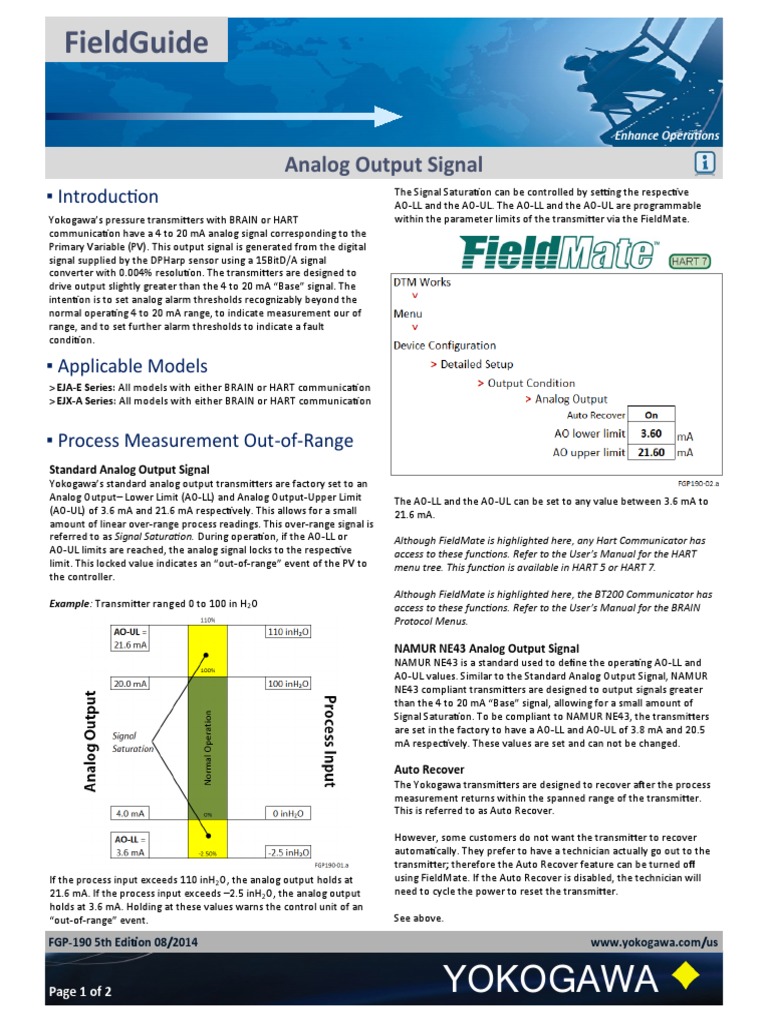In the domain of industrial instrumentation, a certain standard has emerged as a beacon of reliability and precision: NAMUR NE43, which delineates the performance specifications for analog output signals in sensor technology. This document is crucial for engineers and technicians alike, as it bridges the gap between sensor output and measurement instrumentation. Understanding NAMUR NE43 is essential for those looking to foster innovative solutions that are both robust and cost-effective in process automation.
This standard serves as a testament to the evolution of industrial sensing technologies. As industries gravitate toward automation, the clarity of communication between sensors and control systems becomes paramount. Sensors are the eyes and ears of the automated world; they collect data that is vital for making informed decisions. NAMUR NE43 ensures that these data points are transmitted reliably and effectively.
One of the pivotal aspects of NAMUR NE43 is its emphasis on the analog signals produced by sensors. Analog output signals represent continuous values, which is essential in capturing the nuances of complex physical phenomena. This allows for a more faithful representation of real-world variables such as temperature, pressure, or flow. Traditional discrete signals, while simpler, fail to encapsulate the dynamism inherent in such variables.
The standard delineates the technical requirements for sensors designed to transmit analog signals, making it easier for manufacturers to streamline production processes. By adhering to NAMUR NE43, manufacturers can mitigate risks associated with equipment interoperability. The uniformity characterized by this standard enables different devices from varied manufacturers to communicate seamlessly, a necessity in a field where timely data exchange can dramatically affect operations.
Moreover, NAMUR NE43 accentuates the significance of signal quality. The integrity of data is non-negotiable; even minor discrepancies can lead to erroneous interpretations. By providing guidelines on factors such as output impedance, response time, and linearity, NAMUR NE43 acts as a safeguard that enhances the reliability of measurements. This critical focus translates directly into operational efficiency and safety, especially in high-stakes environments such as chemical plants and refineries.
Consider the concept of signal conditioning, a practice often associated with NAMUR NE43 compliance. Signal conditioning refers to the manipulation of signals to meet the specific criteria necessary for better interpretation. This includes amplification, filtering, and analog-to-digital conversion. With compliant sensors, information can be tailored to fit the operational parameters of downstream equipment, invariably improving the system’s overall efficacy.
In examining the practical implications of NAMUR NE43, one cannot overlook its impact on predictive maintenance practices. Modern industry is eschewing the traditional reactive maintenance approach in favor of predictive techniques that leverage data analytics. NAMUR NE43-compliant sensors deliver high fidelity analog signals that feed into analytical models to predict equipment failures. This paradigm shift not only conserves resources but also upholds safety standards by preemptively addressing potential malfunctions.
Furthermore, the deployment of NAMUR NE43-compliant devices can foster an era of sustainability. As sectors across the globe strive for greener operations, the precision afforded by optimized sensor signals enables better monitoring and control of environmental emissions. An accurate awareness of real-time data can lead to a marked reduction in wasteful practices, ultimately contributing to a more sustainable future.
Another area worth exploring is the interplay between NAMUR NE43 and emerging digital technologies. In the age of Industry 4.0, where the Internet of Things (IoT) reigns supreme, the convergence of analog signals with digital infrastructures poses both challenges and opportunities. NAMUR NE43 serves as a strong foundation for establishing interoperability amongst legacy systems and state-of-the-art digital devices. This adaptability enables industries to transition smoothly into more intelligent operational frameworks without abandoning the reliability historically associated with analog signals.
However, translating compliance with NAMUR NE43 into tangible benefits requires a fundamental shift in perspective. Organizations must foster a culture that values precision and accuracy not merely as standards to uphold, but as critical elements of operational success. Training personnel adequately and investing in systems that are capable of processing the rich data provided by compliant sensors can lead to significant dividends.
As industries continue to navigate complexities inherent in instrumentation, NAMUR NE43 stands as a significant milestone in promoting reliable analog output signals. The essentiality of this standard cannot be overstated; it is pivotal in harmonizing the intricate web of sensor networks that underpin modern automation. The commitment to adhering to such standards is not simply about meeting specifications; it is an embodiment of a forward-thinking ethos essential for innovation and efficiency in ever-evolving operational landscapes.
In conclusion, NAMUR NE43 is more than just a technical guideline; it is a philosophical approach to instrumentation that embraces quality, reliability, and operational excellence. As industries redefine their methods and embrace new technologies, the principles ushered in by NAMUR NE43 promise to uphold the standards of excellence that are increasingly essential in today’s competitive environment. Understanding and incorporating NAMUR NE43 will not only result in enhanced operational efficiencies but will also pave the way for future innovations, ensuring that industries are well-equipped to face the challenges of tomorrow.










